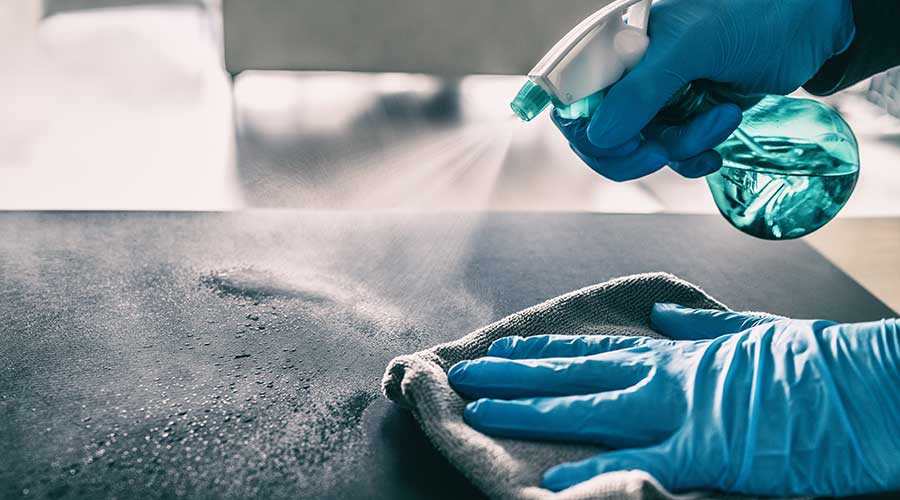It’s that time of year again when the misery of norovirus strikes the United States. Each year, the pathogen causes an average of 900 deaths, 109,000 hospitalizations, 465,000 emergency room visits, and 19 to 21 million illnesses, according to the U.S. Centers for Disease Control and Prevention (CDC).
The agency reports national norovirus trends as three-week moving averages of positive test rates. So far in the 2023–’24 season, infections peaked the week of Dec. 30, 2023, at 13 percent positivity. Rates have since oscillated, with 12.3 percent positivity the week of Feb. 17, 2024. Norovirus is commonly called stomach flu, though it is unrelated to influenza. Its nicknames include winter vomiting disease and the cruise ship virus because it spreads easily among people in close quarters.
Norovirus can survive on surfaces for two weeks. Cleaning and decontaminating surfaces is critical to removing and destroying the virus. Due to misinformation or ignorance, norovirus can break out in any facility where the cleaning staff is not properly equipped or trained for proper clean up. Here is what environmental services managers and staffs need to know:
- The virus is airborne when people are projectile vomiting. The range of the particles carrying the virus is up to a 25-foot radius.
- The virus can live on an inanimate surface for up to two days and in water indefinitely.
- The virus is very tiny and difficult to eradicate with normal cleaning and disinfection.
- Cleaning staffs must be equipped with a disinfectant from EPA List G. Limit the search to products that are non-toxic, non-corrosive, dilutable and with a dwell time of one-two minutes
Related: Handwashing is Key to Prevent the Spread of Norovirus
Clean up
Follow these steps to properly clean and reduce the spread of norovirus in the facility:
- Remove vomit or stool. Block-off and clear individuals from the exposed area immediately. Put on personal protective equipment — disposable gloves, N-95 mask and plastic apron — to reduce exposure to the virus. Use disposable absorbent material — paper towels, kitty litter, baking soda or disposable cloths — to soak up visible vomit or stool. Scrape up absorbent material containing vomit or stool. Dispose of soiled items, waste, and gloves in a plastic trash bag. Throw away disposable items within a 25-foot radius of vomit.
- Wash hands. Put on clean gloves. Take disposable cloths soaked in soapy water and wipe up the remaining vomit or stool. Rinse the surface well with clean cloths soaked in plain water.
- Wipe. Clean the area with dry paper towels and dispose of all soiled items and waste in a plastic trash bag.
- Isolate. Isolate the contaminated area for two hours because norovirus particles can remain in the air for two hours after an incident.
Decontaminate
The soiled area needs to be decontaminated. Use a high denier microfiber cloth for final disinfection using a product from EPA List G after the bulk has been picked up. Use an ultraviolet (UV) light with the ambient light down low to look for splatters of vomit. If body fluids are on soft, nonporous surfaces such as bath linens, patient bedding, upholstered furniture, curtains or carpet, they cannot be disinfected. Launder the items that allow it. Other items that cannot go in a washing machine should be hot water extracted. Inspect the area with UV light for thoroughness of the decontamination process.
J. Darrel Hicks, BA, MESRE, CHESP, Certificate of Mastery in Infection Prevention, is the past president of the Healthcare Surfaces Institute. Hicks is nationally recognized as a subject matter expert in infection prevention and control as it relates to cleaning. He is the owner and principal of Safe, Clean and Disinfected. His enterprise specializes in B2B consulting, webinar presentations, seminars and facility consulting services related to cleaning and disinfection. He can be reached at darrel@darrelhicks.com, or learn more at www.darrelhicks.com.

 Rethinking Strategies for Construction Success
Rethinking Strategies for Construction Success From Touchless to Total Performance: Healthcare Restroom Design Redefined
From Touchless to Total Performance: Healthcare Restroom Design Redefined New York State Approves $53M Construction Program at Niagara Falls Memorial Medical Center
New York State Approves $53M Construction Program at Niagara Falls Memorial Medical Center How Health Systems Are Rethinking Facilities Amid Margin Pressure
How Health Systems Are Rethinking Facilities Amid Margin Pressure Ground Broken on New Medical Office Building in Scottsdale, AZ
Ground Broken on New Medical Office Building in Scottsdale, AZ